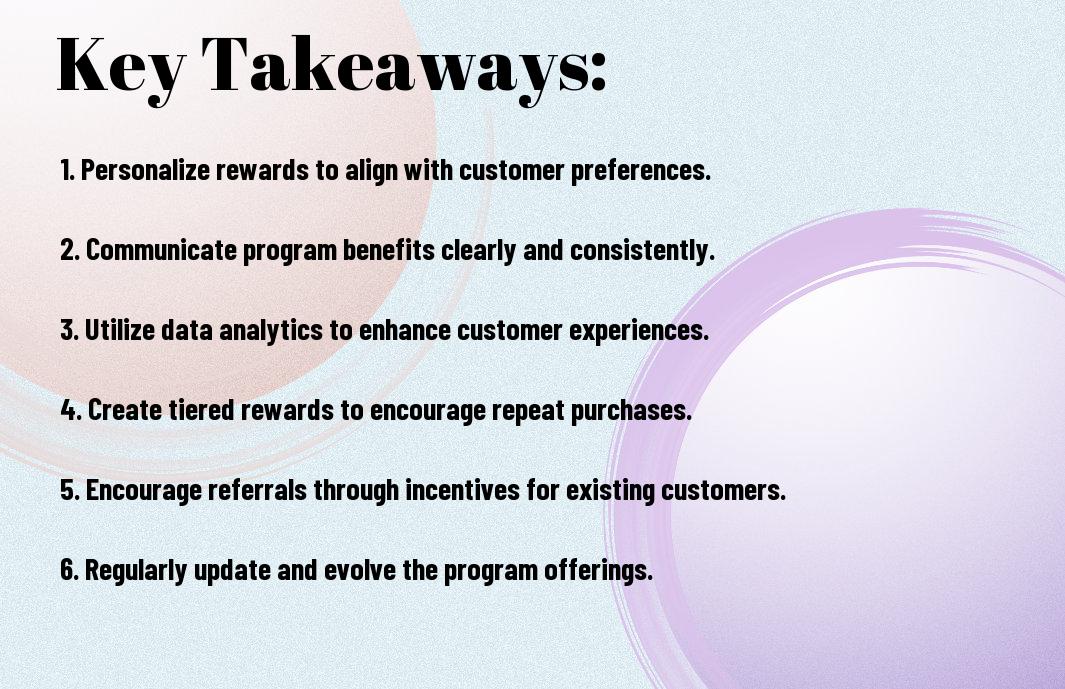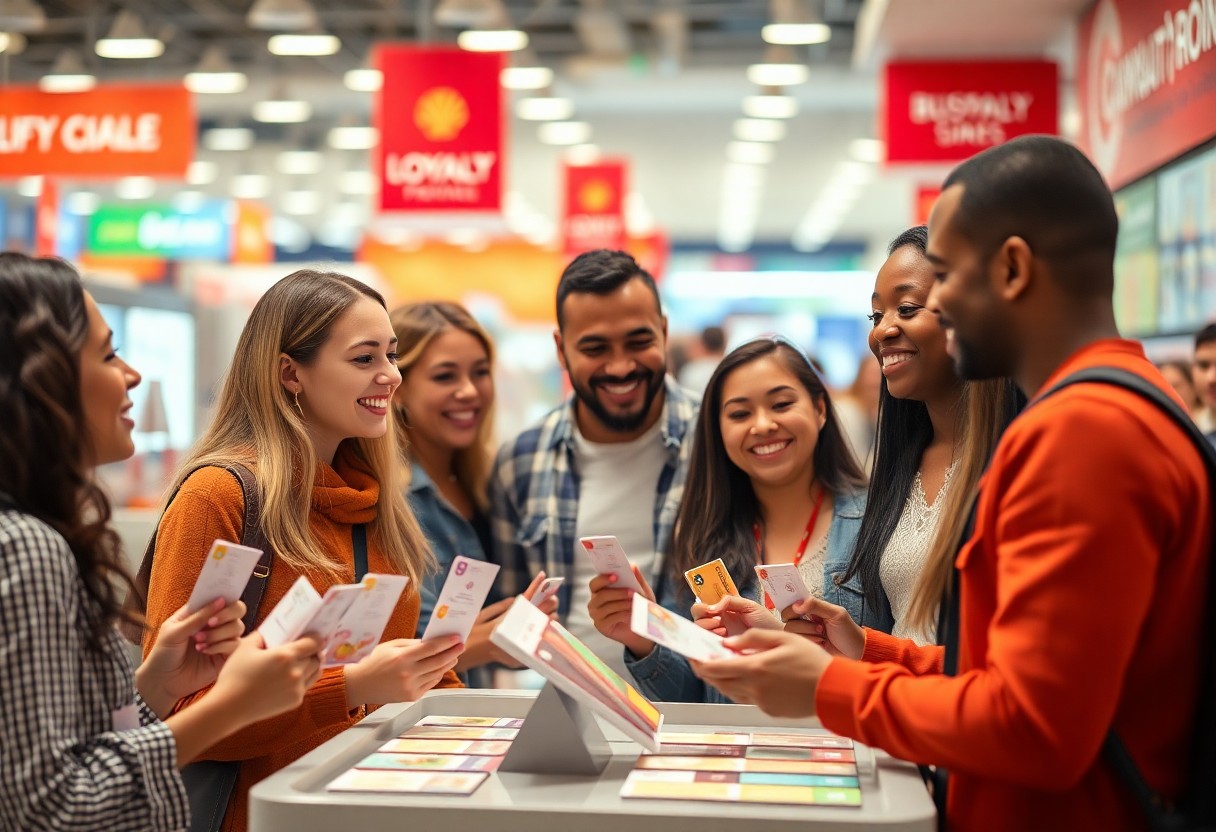You can significantly boost your revenue by implementing effective customer loyalty programs. These programs not only enhance customer retention but also encourage repeat purchases and increase overall satisfaction. By understanding your customers’ preferences and designing rewards that resonate with them, you can create a compelling loyalty strategy that drives long-term success. In this post, we’ll explore practical steps and best practices to help you establish a loyalty program that keeps your customers coming back for more.
Key Takeaways:
- Understand Customer Preferences: Tailor your loyalty programs to align with what your customers value most, such as discounts, exclusive offers, or personalized experiences.
- Create Engaging Rewards: Offer diverse and appealing rewards that encourage repeat purchases, fostering a stronger emotional connection with your brand.
- Leverage Data Analytics: Use customer data to analyze behaviors and preferences, allowing for the optimization of loyalty programs to maximize revenue and customer satisfaction.

Understanding Customer Loyalty Programs
For businesses aiming to enhance their revenue, understanding customer loyalty programs is vital. These programs are strategic initiatives designed to foster repeat business by incentivizing customers to choose your products or services over competitors. By creating a bond of trust and satisfaction, you not only retain customers but also encourage brand advocacy, ultimately driving growth and profitability.
Definition and Importance
Customer loyalty programs are structured marketing strategies aimed at encouraging repeat purchases. They are important in building long-term relationships with customers. Ultimately, they boost sales and create a more predictable revenue stream.
Types of Customer Loyalty Programs
Among various loyalty programs, you’ll find options that cater to different consumer behaviors and preferences. Here’s a breakdown of common types:
- Points-based systems
- Tiered rewards programs
- Cashback offers
- Membership clubs
- Exclusive access rewards
Knowing the right type of loyalty program for your business can significantly affect your customer retention strategy.
| Type | Description |
| Points-Based Programs | Customers earn points per purchase that can be redeemed. |
| Tiered Rewards | Offers increasing benefits as customers spend more. |
| Cashback Offers | Gives a percentage of purchases back to customers. |
| Membership Programs | Involves a fee for exclusive access to benefits. |
| Exclusive Events | Rewards loyal customers with special events or previews. |
Between the various types, each program holds unique benefits and can align with different business models and customer preferences. You might consider how each type addresses the needs of your audience.
- Targeted marketing campaigns
- Engagement through social media
- Special promotions for loyal customers
- Collaborations with other brands
- Data collection for better insights
Knowing how to effectively implement these programs can enhance customer loyalty and drive revenue growth.
| Strategy | Benefit |
| Personalization | Builds strong customer connections. |
| Feedback Collection | Gives insights into customer preferences. |
| Regular Communication | Keeps your brand top-of-mind. |
| Easy Redemption | Encourages participation and usage. |
| Customer Segmentation | Targets different groups effectively. |
Understanding the different strategies in these loyalty programs can help you tailor your approach to meet specific customer needs.

Benefits of Implementing Customer Loyalty Programs
Even in a competitive market, customer loyalty programs can significantly enhance your business by fostering long-term relationships with your clients. When you offer rewards and incentives, you create a unique value proposition that encourages customers to return. By integrating these programs into your operations, you not only boost satisfaction but also cultivate a community around your brand, leading to sustained growth and increased revenue.
Increased Revenue
Programs designed to reward loyal customers directly correlate with increased sales. When customers feel appreciated and valued through effective loyalty incentives, they are more likely to spend more, return for repeat purchases, and even refer friends. This increase in customer spending can create a significant impact on your overall revenue, making it a strategic investment for your business.
Enhanced Customer Retention
Alongside increased sales, loyalty programs also play a pivotal role in enhancing customer retention. As you create a sense of belonging and appreciation, your customers are more likely to stick with your brand rather than explore competitors. This not only reduces acquisition costs but also ensures a reliable revenue stream over time.
Loyalty programs help you build a strong rapport with your most engaged customers. By offering exclusive perks, personalized rewards, or early access to products, you create emotional connections that inspire customers to stay loyal. This increases their lifetime value and transforms one-time buyers into brand advocates, enabling you to sustain a competitive edge in your market.
Designing an Effective Loyalty Program
Keep your customers’ preferences at the forefront when designing your loyalty program. An effective loyalty program should resonate with your audience, allowing you to create engaging incentives that encourage repeat business. Consider offering rewards that align with your brand values while also enhancing the overall customer experience, leading to stronger connections and increased revenue.
Identifying Customer Needs
By understanding what your customers truly value, you can tailor your loyalty program to meet their desires. Conduct surveys, analyze purchase behaviors, and actively seek feedback to gain insights into customer expectations. This approach ensures that your program aligns with their needs, ultimately driving higher satisfaction and loyalty.
Structuring Rewards and Incentives
Before you launch your loyalty program, define clear, attainable rewards that motivate your customers to engage more deeply with your brand. Your structure must be easy to understand, encouraging participation without overwhelming your audience. Create a mix of instant rewards and long-term benefits to keep customers consistently interested and invested.
Loyalty programs thrive on thoughtful reward structures that inspire consistent participation. Consider tiered rewards that grow in value with increased spending or engagement, fostering a sense of achievement. Offering personalized incentives based on individual purchase histories or preferences can further enhance the appeal. Ultimately, an engaging rewards system positions your brand as one that truly values its customers, helping to nurture loyalty over time.
Technology and Tools for Loyalty Programs
Despite the traditional methods of customer engagement, leveraging technology is crucial for crafting effective loyalty programs. Incorporating various tools can streamline your operations, enhance customer experience, and ultimately drive revenue growth. From mobile apps to sophisticated customer relationship management systems, the right technology can transform how you interact with your customers and strengthen their loyalty to your brand.
Software Solutions
Beside engaging directly with your audience, implementing the right software solutions is key to managing your loyalty program effectively. Look for platforms that provide user-friendly interfaces, easy integration with your existing systems, and features that allow for tracking and managing customer rewards. These solutions can significantly enhance your efficiency and provide insights that are vital for your program’s success.
Data Analytics for Customization
The power of data analytics can greatly enhance your customer loyalty initiatives. Analyzing customer behavior and preferences allows you to tailor your offerings, making each interaction feel personalized. This customization not only meets customer expectations but also fosters deeper emotional connections, driving higher levels of engagement and retention.
With the right data analytics tools, you can gather insights about your customers’ buying patterns, preferences, and feedback. By utilizing this information, you can personalize your loyalty programs, offering rewards that resonate with individual customers or target specific groups. Personalized experiences help keep your brand at the forefront of customers’ minds, leading to increased loyalty and ultimately higher revenue. The more you understand your audience, the more effectively you can cater to their needs, ensuring long-term loyalty to your brand.
Marketing Your Loyalty Program
Many businesses overlook the importance of marketing their loyalty programs effectively. Promoting your program not only informs customers about the benefits they can receive but also reinforces their commitment to your brand. Utilize various channels like social media, email newsletters, and in-store signage to create buzz around your loyalty offerings and ensure your customers are aware of how they can take advantage of these incentives.
Promotion Strategies
At the outset, it’s important to employ diverse promotion strategies to reach your audience. Consider launching targeted campaigns through social media ads and email blasts, highlighting your loyalty program’s features and benefits. Utilize punchy graphics and compelling calls to action that motivate customers to join and participate, ensuring your messaging is consistent across all platforms.
Engaging Customers
Besides effective promotion, engaging your customers is key to a successful loyalty program. Frequent touchpoints, such as personalized messages and exclusive offers, will keep them interested and invested in your brand. Initiate conversations on social media or through surveys to gather feedback and adapt your strategies based on their preferences.
Another way to enhance customer engagement is by integrating gamification elements into your loyalty program. You can encourage customers to complete challenges or reach milestones, giving them a sense of achievement. Celebrate their progress publicly, and retain their interest by adding new incentives regularly. This way, you not only nurture loyalty but also foster a community around your brand, making customers feel valued and connected.
Measuring Success and Making Adjustments
All businesses must track the effectiveness of their customer loyalty programs. Utilizing data-driven insights allows you to identify areas of success and those needing improvement, ensuring continuous growth in your revenue. By regularly assessing your program, you can adapt it to fit your customers’ evolving needs, leading to improved engagement and satisfaction.
Key Performance Indicators (KPIs)
Success in your loyalty program hinges on tracking specific KPIs that reflect its impact. Metrics such as customer retention rates, average order value, and participation levels help you evaluate its effectiveness. By analyzing these indicators, you can make informed decisions to refine your strategy and optimize your program.
Feedback and Continuous Improvement
After implementing your loyalty program, gathering feedback from your customers is imperative for ongoing success. Actively soliciting their thoughts on the program’s features and benefits will help you identify what resonates with them and what may be lacking, allowing you to adjust accordingly.
In fact, customer feedback serves as a valuable resource for continuous improvement. Engaging with your audience through surveys or direct conversations can unveil insights that may not be apparent through KPI analysis alone. By incorporating their suggestions and addressing concerns, you can enhance your loyalty program, foster greater satisfaction, and ultimately increase your revenue. This approach demonstrates that you value their opinions, strengthening the bond between your brand and customers.
Summing up
With these considerations, you can effectively enhance your revenue by implementing customer loyalty programs that resonate with your audience. By understanding their preferences and creating tailored rewards, you build lasting relationships that drive repeat business. Additionally, utilizing strategies such as personalization and customer engagement will further solidify this loyalty. For deeper insights, explore Next in loyalty: Eight levers to turn customers into fans to unlock more potential in your loyalty initiatives.
Q: What are customer loyalty programs, and how do they contribute to increasing revenue?
A: Customer loyalty programs are marketing strategies designed to reward and encourage repeat business from customers. By offering incentives such as discounts, exclusive offers, or points redeemable for rewards, these programs help to foster a sense of appreciation and connection between businesses and their customers. Increased customer retention leads to higher sales volumes, as loyal customers are more likely to make frequent purchases, promote the brand to others, and spend more over time. Additionally, a well-structured loyalty program can attract new customers who wish to partake in the benefits offered.
Q: How can a business effectively design a customer loyalty program?
A: To design an effective customer loyalty program, businesses should begin by understanding their target audience and preferences. Key steps include defining the program’s goals, selecting appropriate rewards that resonate with customers, and establishing clear criteria for earning rewards. It’s imperative to ensure that the program is easy to join and understand, as complicated structures may deter participation. Additionally, incorporating technology such as mobile apps or digital platforms can enhance user experience and provide data analytics to track participation and adjust the program based on customer feedback and behaviors.
Q: What are some best practices for promoting a customer loyalty program?
A: To effectively promote a customer loyalty program, businesses should leverage multiple marketing channels. This includes utilizing social media platforms, email newsletters, and in-store signage to create awareness. Engaging existing customers through personalized communication that highlights the benefits and rewards of the program can also encourage participation. To drive initial sign-ups, consider offering a limited-time promotion or bonus rewards for early adopters. Furthermore, encouraging current members to share their experiences on social media can help to organically expand the program’s reach, attracting new participants who value community recommendations.
